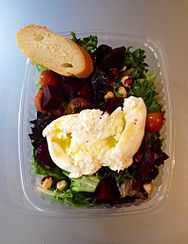Burrata

Burrata is a fresh Italian cheese made from mozzarella and cream. The outer shell is solid mozzarella, while the inside contains both mozzarella and cream, giving it an unusual, soft texture. It is also defined by some sources as an outer shell of mozzarella filled with butter or a mixture of butter and sugar. It is usually served fresh and at room temperature. The name "burrata" means "buttered" in Italian.
History
Burrata is a typical product of Murgia in the south of Italy. It is produced from Italian buffalo's and/or cow's milk, rennet, and cream. Burrata was probably first made around 1920 but may have origins dating back to about 1900[1] on the Bianchini farm in the city of Andria within Murgia, an area in the Apulian region. In the 1950s, it became more widely available after some local cheese factories began producing it. It is generally believed that the factories found making it to be a useful way to use up the ritagli ("scraps" or "rags") of mozzarella.
Established as an artisanal cheese, burrata maintained its premium-product status even after it began to be made commercially in factories throughout Apulia.[2]
Production

Burrata starts out much like mozzarella and many other cheeses, with rennet used to curdle the warm milk. But then, unlike other cheeses, fresh mozzarella curds are plunged into hot whey or lightly salted water, kneaded, and pulled to develop the familiar stretchy strings (pasta filata), then shaped in whatever form is desired.
When making burrata, the still-hot cheese is formed into a pouch, which is then filled with scraps of leftover mozzarella and topped off with fresh cream before closing. The finished burrata is traditionally wrapped in the leaves of asphodel, tied to form a little brioche-like topknot, and moistened with a little whey. The asphodel leaves should still be green when the cheese is served to indicate the cheese's freshness.[3] More recently, the cheese is often sold in a plastic bag or container.
Serving indications
When the burrata is sliced open, ritagli-thickened panna (cream) flows out. The cheese has a rich, buttery flavor and retains its fresh milkiness. It is best when eaten within 24 hours and is considered past its prime after 48 hours. The flavor and different textures of the inside and outside make it go well with salad,[4] prosciutto crudo, crusty bread, fresh tomatoes with olive oil, cracked black pepper, or pasta.
References
- ↑ "Burrata, la regina dei formaggi". Retrieved 30 March 2011.
- ↑ Karen Hochman (October 2007). "Burrata Cheese". Cheese-Butter-Yoghurt Product Reviews. The Nibble. Retrieved 17 March 2011.
- ↑ Roberts, Genevieve (2 March 2011). "Burrata: Britain's new Big cheese". The Independent. Retrieved 7 September 2013.
- ↑ Nicole Buergers (July 4, 2011). "What is Burrata?". The Queso Queen (cheese blog).
| ||||||||||||||||||